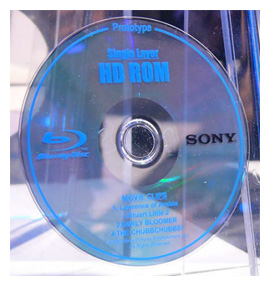|
You are reading the older HTML site
Positive Feedback
ISSUE
27
The Emperor Has No Clothes: the AV
Industry in Chaos
There is a line in the movie The Smartest Guys in the Room about the deceit connected with the financial status of Enron. It seems to me that the line is analogous to the present state of the audio/video industry. First, there is the high-definition format battle, pitting Blu-Ray against HD-DVD. Blu-Ray, with its higher storage capacity and data transfer rate, is technically the better format, but Beta was better than VHS, and died anyway. I think that the public will be slow to buy players until the format war is over, or there are players that will accept both formats. Sony has blocked several manufacturers from making players that play both.
One problem is that if you buy either format, you will not be able to watch all of the movies being released. Also, the release of Blu-Ray and HD-DVD players has been premature, as there have been problems with both the players and the discs. The problems with the players include connectivity, operation, and picture quality. The initial choice of movies has been poor, and most are darkly shot, without strong color or detail. The choice of scenes on the demo discs has also been poor. In some cases, an upconverted DVD picture looks better than the HD version. The only pictures I have seen that look really good are from non-movie, high-definition video. Then there is the problem with televisions. Last year’s models upconverted to 1080p, but did not take a 1080p input. Some of this year’s sets will take a 1080p signal through the HDMI input. HDMI is used for two reasons—it makes hookup simpler, and it protects the signal from being pirated. There are three versions of HDMI, all of which can handle 1080p signals: 1.1, 1.2, and the new 1.3, which is supposedly coming out in early fall 2006. Audio will be the big thing with this version, as it will handle DTS-HD Master and DD-True HD, and I have read that these audio formats will only be output to 1.3 HDMI. The HDMI 1.3 cable also has the ability to carry higher-resolution video than is now available, with deep-bit color capacity. Although the 1.3 chips are coming out in the fall, they will not appear in receivers, players, and TVs until next year, and it will be even longer before they appear in audiophile equipment.
DTS Master Sound HD will probably offer the best sound because of its data transfer rate, but the only surround-sound systems that are required on Blu-Ray or DVD-HD are the pathetic Dolby Digital or DTS. Of the thirty or so titles I have seen, on both HD-DVD and Blu-Ray, only one has a HD audio track. Most have only Dolby Digital. Sending a surround-sound signal to a TV is worthless, since TVs do not have built-in AV preamps. This means that the HDMI output is meant to go to an AV preamp or receiver, which requires a $100 HDMI cable. Audio over HDMI is probably good enough for TV sound, although I am not sure how I feel about putting sound through the very small wires in a HDMI cable. The new HD audio standards have a good chance of giving us audiophile video sound for the first time. Standard Dolby Digital has a digital data transfer rate of 448,000 bits per second. The transfer rate of DVD DTS is 1,500,000 bits per second, but most of the time, because of time constraints, they only use a little over half that. This explains the difference in sound quality of DTS discs. The transfer rate for Blu-Ray with DTS Master HD is 24,500,000 bits per second. HD-DVD with DTS HD Master or DD True HD is about 18,000,000 bits per second. Onboard decoding of advanced audio formats can be accomplished via 5.1 or 7.1 audio outputs, but there are a couple of problems with this. First, most receivers or preamps only have one 5.1 input. To plug in the new players, you will need to eliminate the inputs from DVD, SACD, and DVD-A players. The new-format players will also have 7.1 outputs, but very few pieces of gear require them, and it appears that the advanced formats will only be output through HDMI 1.3. Nevertheless, it is not clear whether current HDMI cables will be able to carry the extra bandwidth of 1.3. With the death of DVD-A and near-death of SACD, the audiophile is left with little hope of better sound quality for at least a couple of years, until music discs can use the new formats. It will be even longer before any real selection will be available. The current Blu-Ray or HD-DVD players will most likely be boat anchors within two years, mostly because of their audio playback. There is also the chance that one or both of the formats will fail because of consumer apathy. It will probably take a couple of years to see which of these media will survive. The only way I can see them surviving is the introduction of machines that play all audio and video formats at a reasonable price. The number of software titles will be controlled by the number of players sold. The rental market will be very important. Most people do not want to buy a movie for $30 and watch it once, and most consumers will not be willing to replace their DVD collections with the new discs. To get the most out of the new formats, the consumer should wait at least six months, then buy a new TV, preamp, and player. My suggestion is to wait until the introduction of HDMI 1.3.
|



